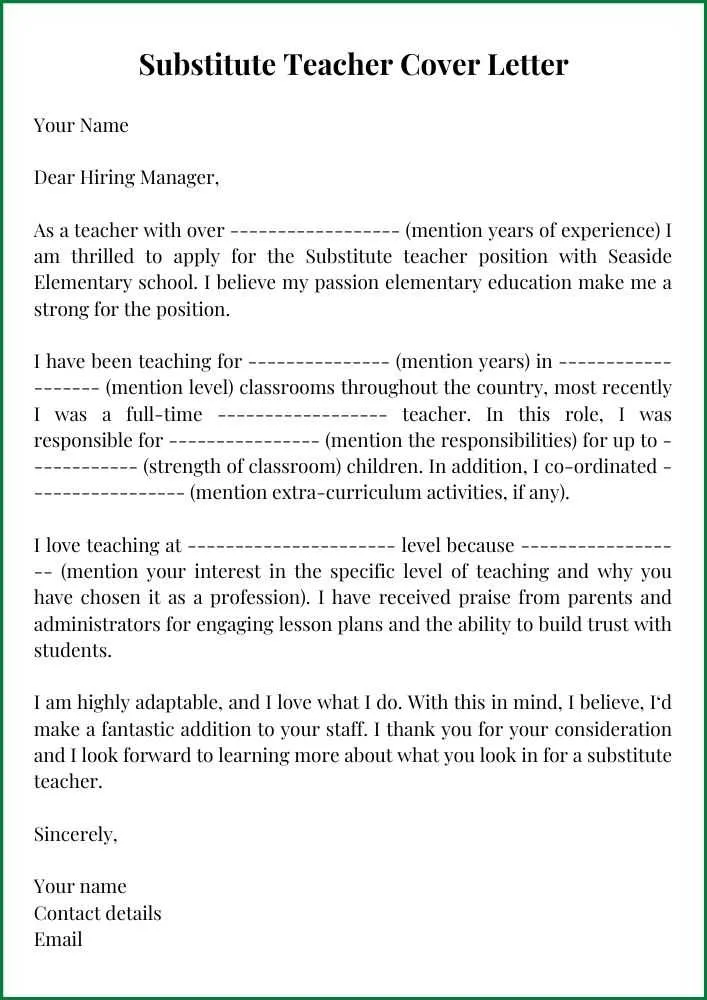Understanding the Substitute Teacher Role
A substitute teacher plays a crucial role in the education system, stepping in to maintain a consistent learning environment when a regular teacher is absent. This can be due to illness, professional development, or personal leave. The primary responsibility of a substitute teacher is to deliver pre-planned lessons, manage the classroom, and ensure student safety and well-being. The role demands adaptability, strong communication skills, and the ability to quickly establish rapport with students. A substitute teacher must be prepared to work with different age groups, subjects, and teaching styles, making each day a unique experience. They become essential in ensuring students do not fall behind in their studies. As such, presenting your skills effectively in a cover letter is key to securing a position.
Essential Components of a Substitute Teacher Cover Letter
Crafting a compelling cover letter is essential for substitute teachers seeking employment. It serves as a personal introduction, highlighting your qualifications and enthusiasm for the role. A well-structured cover letter includes several key components. First, it should begin with your contact information, followed by the date and the recipient’s details. A professional salutation sets the tone, while the body of the letter should emphasize your skills, experience, and passion for teaching. Make sure to demonstrate your interest in the specific position and conclude with a call to action. Finally, proofread carefully, as attention to detail is crucial in education. Your cover letter is your first impression, making its structure and content vital to your success.
Contact Information
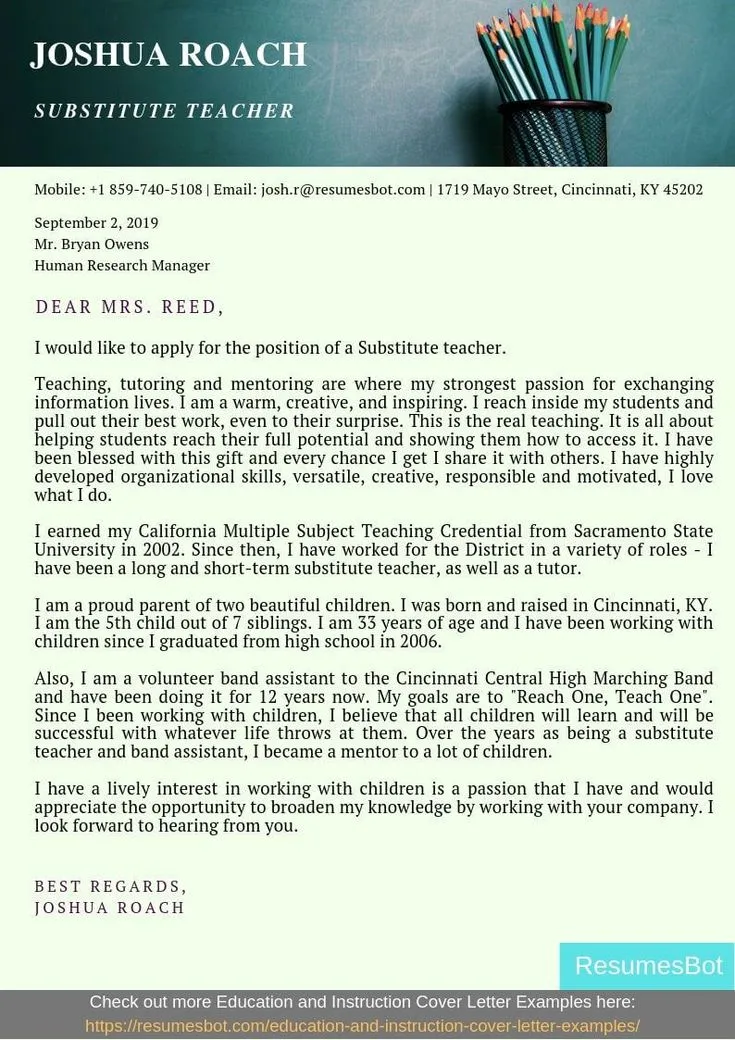
At the top of your cover letter, clearly state your contact information. Include your full name, address, phone number, and email address. This information allows the hiring manager to easily reach you. Ensure your email address is professional. A clear and professional presentation of your contact details shows organization and professionalism. It’s also useful to have your contact information match your resume; this makes it easier for the reader to follow up with you. Double-check your contact information for accuracy to avoid any miscommunication and ensure you receive a response.
Date and Recipient Information
Following your contact information, include the date and the recipient’s details. Start with the current date. Next, write the name and title of the person you are addressing, the school’s name, and the school’s address. If you know the name of the hiring manager, address the letter directly to them. If not, research the school’s website to find the appropriate contact person. Addressing the letter to a specific individual demonstrates that you have taken the time to research the school, showing your interest in the position. This attention to detail can set your application apart.
Professional Salutation
Begin your cover letter with a professional salutation. If you know the hiring manager’s name, use “Dear Mr./Ms. [Last Name].” If you are unsure, use a generic greeting like “Dear Hiring Manager” or “Dear [School Name] Hiring Committee.” Avoid overly casual greetings like “Hi” or “Hello.” A formal salutation sets a professional tone from the outset. Proper use of salutations is crucial in the education sector. It is a sign of respect and attention to detail that hiring managers seek in their substitute teachers. Make sure you research and correctly use the recipient’s name and title for a personalized touch.
Highlighting Relevant Skills and Experience
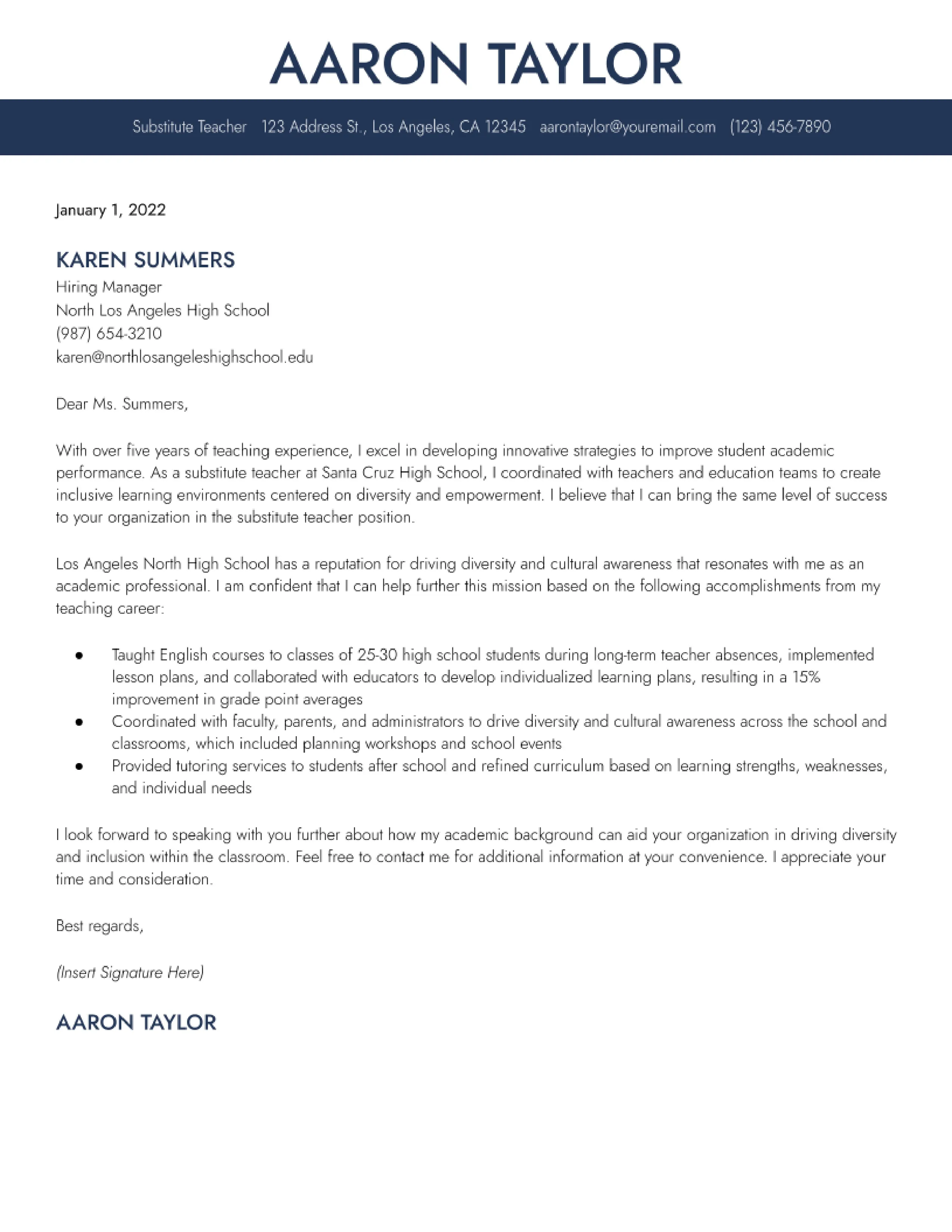
The body of your cover letter is where you highlight your relevant skills and experience as a substitute teacher. Focus on what makes you qualified and a good fit for the role. Provide specific examples of your classroom management abilities, your adaptability to different situations, and your communication skills. Emphasize any experience with lesson plans, working with different age groups, or using educational technologies. Make sure to tailor the information to the specific requirements of the school or district you are applying to. The aim is to show how your skills align with their needs and show how you could be a valuable asset to the school community.
Classroom Management Skills
Classroom management is a key aspect of a substitute teacher’s role. In your cover letter, showcase your skills in this area. Describe your strategies for maintaining order, engaging students, and handling disruptive behavior. Include examples of how you have successfully managed classrooms, such as implementing clear expectations, using positive reinforcement, or addressing conflicts effectively. Highlight any training or experience in classroom management techniques. Mention your ability to create a positive and productive learning environment. Emphasize your commitment to student safety and well-being, a top priority for schools. Mentioning such key skills reassures the hiring manager of your capacity to run an organized classroom.
Adaptability and Flexibility
Substitute teaching requires a high degree of adaptability and flexibility. In your cover letter, demonstrate your ability to adjust to different teaching styles, age groups, and subjects. Provide examples of how you have handled unexpected situations, such as changes in lesson plans or unforeseen classroom dynamics. Mention your willingness to learn and implement new strategies. Showcase your ability to remain calm under pressure and effectively manage time and resources. Flexibility is one of the essential attributes that schools search for. Your ability to adapt quickly shows you can deal with the various challenges that substitute teachers frequently face. Adaptability will help you excel in diverse teaching scenarios.
Communication and Collaboration
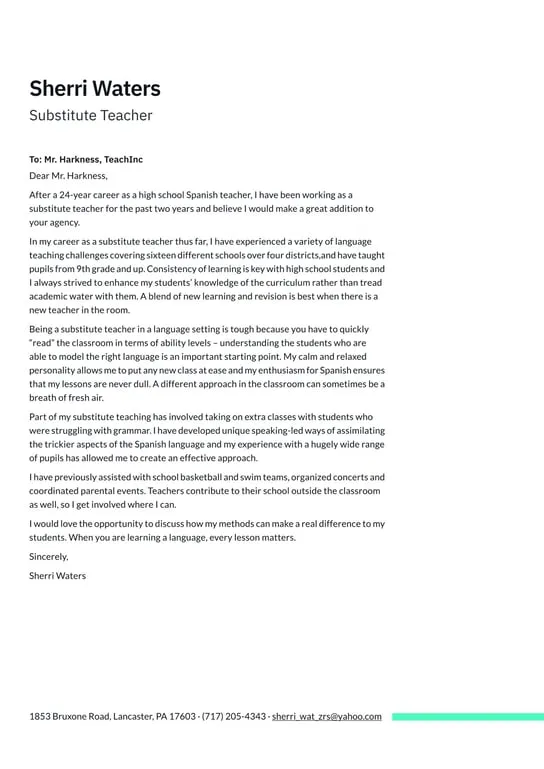
Effective communication and collaboration are essential for successful substitute teaching. Your cover letter should highlight your ability to communicate clearly and effectively with students, teachers, parents, and administrators. Describe your experience in communicating with diverse groups of people and your strategies for fostering positive relationships. Include any experience in collaborating with other educators to implement lesson plans or address student needs. Demonstrate your ability to follow instructions, seek clarification when needed, and provide feedback. Emphasize your commitment to teamwork and your understanding of the importance of communication. This way, you will demonstrate your ability to create a supportive and collaborative environment.
Demonstrating Enthusiasm and Passion
Expressing your enthusiasm and passion for teaching is crucial. In your cover letter, let your passion shine through. Describe your genuine interest in working with students and your dedication to their educational success. Share what motivates you to be a substitute teacher and what you find rewarding about the profession. Show how excited you are about the prospect of supporting a school and its students. By conveying enthusiasm, you show potential employers that you are dedicated, motivated, and willing to go the extra mile. Making your passion evident can make a lasting impression and greatly enhance your cover letter.
Expressing Your Interest in the Position
Clearly express your interest in the specific substitute teacher position you are applying for. Mention the school name, grade level, or subject area, as appropriate. Explain why you are drawn to this particular school or district. If you have researched their mission, values, or programs, reference them to show your interest and understanding. Tailor your letter to the specific requirements of the job posting, ensuring your skills and experiences align with their needs. By showing that you are interested and a good match for the position, you can significantly enhance your application. It will let the school know you’re not just looking for any job, but you’re seeking to contribute to their particular environment.
Showcasing Your Knowledge of School Policies
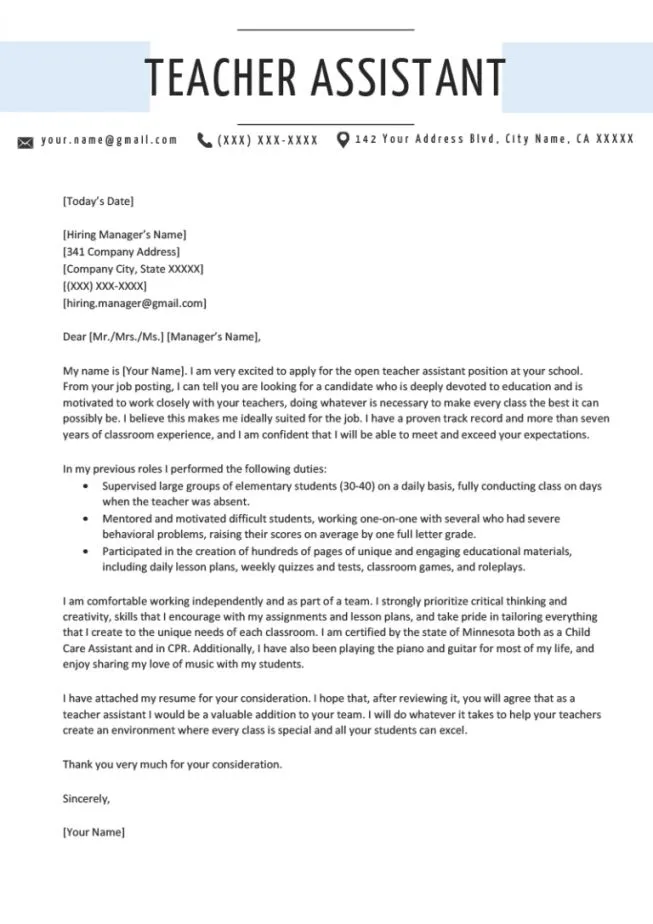
Demonstrate your familiarity with school policies and procedures in your cover letter. If you have experience with specific school districts, mention this and highlight your understanding of their policies regarding student safety, classroom management, and other relevant areas. Even if you are not familiar with a specific school’s policies, you can show your willingness to learn and adapt. You might state that you are eager to familiarize yourself with their policies. If possible, research the school’s website or contact them to gain insights. Demonstrate your commitment to following school protocols will help you gain the trust of the hiring manager and reassure them that you understand the responsibilities of being a substitute teacher.
Including a Call to Action
Concluding your cover letter with a strong call to action encourages the hiring manager to take the next step. Express your availability for an interview and specify how they can contact you. Reiterate your interest in the position and your enthusiasm for the opportunity. Thank the hiring manager for their time and consideration. Keep it short, direct, and professional. A well-executed call to action can prompt the hiring manager to reach out to you. Including this shows you are eager and available to discuss your application further, boosting your chances of being selected for the role.
Formatting and Proofreading Your Cover Letter
Pay close attention to formatting and proofreading your cover letter. Use a professional font like Times New Roman, Arial, or Calibri. Ensure your letter is easy to read and well-organized with clear paragraphs. Use standard 1-inch margins and single spacing. Before submitting, carefully proofread your cover letter for any grammar, spelling, or punctuation errors. It is a good idea to have someone else review it. A polished cover letter demonstrates your attention to detail, which is a critical skill in teaching. Your cover letter’s appearance is just as important as its content, so make sure it is presentable and professional.
Using a Professional Tone
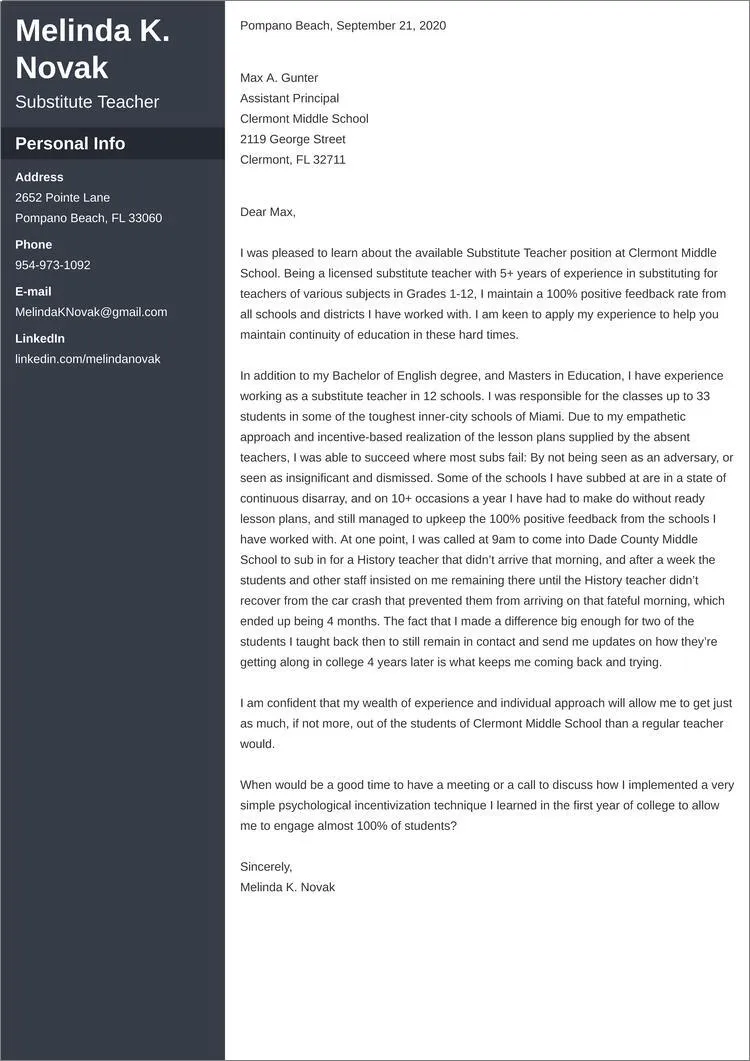
Maintain a professional tone throughout your cover letter. Use formal language and avoid slang or colloquialisms. Be respectful and courteous in your interactions. Keep the tone positive and enthusiastic, but avoid sounding overly casual or informal. The goal is to demonstrate your professionalism and respect for the position. This will show the hiring manager that you understand the standards and expectations of a teaching environment. It also demonstrates you can communicate professionally with students, parents, and colleagues. A professional tone helps establish your credibility and increases your chances of being selected for the role.
Proofreading for Errors
Proofreading your cover letter is a crucial step. Errors can undermine your credibility and leave a negative impression. Carefully read your cover letter, checking for spelling, grammar, punctuation, and formatting errors. Use a spell-checker and grammar checker, but do not rely on them entirely. Have someone else review your letter as a fresh pair of eyes can catch mistakes that you might miss. Ensure all information is accurate, including dates, names, and contact details. Proofreading ensures that your cover letter is polished and professional. It shows the hiring manager that you pay attention to detail, a highly valued trait in teaching. Make proofreading a standard part of your application process.
Finalizing and Submitting Your Cover Letter
Once you have completed all the steps, finalize and submit your cover letter. Make sure your cover letter is tailored to the specific job and the school you are applying to. Double-check that you have included all the required information and have addressed all the points. Save your cover letter as a PDF to preserve its formatting and make it easy for the hiring manager to open. Send your cover letter and resume as attachments in your email. Follow the instructions in the job posting to submit your application. Sending a well-crafted and error-free cover letter demonstrates your professionalism and interest in the position.
